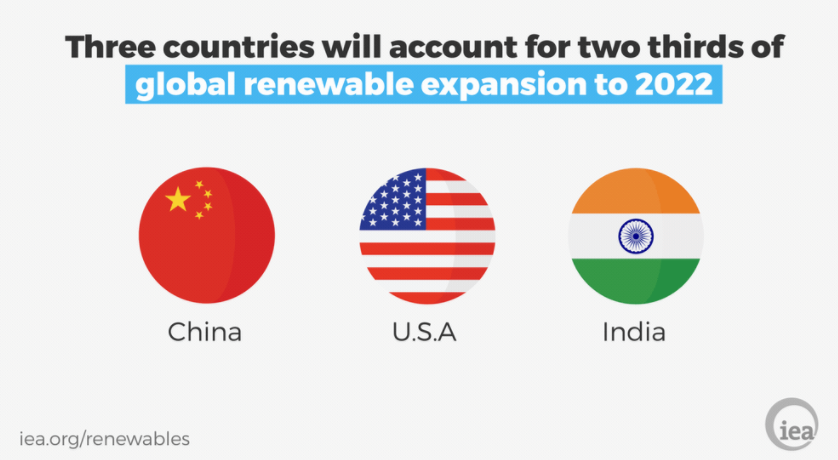|
Secretaris-Generaal VN
Geregistreerd: 18 mei 2005
Locatie: Limburg
Berichten: 50.249
|

Citaat:
Oorspronkelijk geplaatst door patrickve

En de mop is: het verdrag van Parijs gaan bovendien niet veel aan het klimaat doen.
|
Het staat erin hé.
Citaat:
|
Vergelijk de EU eens (die dus "doelstellingen haalt") met China of de VS of India ("die het aan hun laars lappen")
|
India en China? Ik denk dat je niet echt op de hoogte bent.
Citaat:
https://cleantechnica.com/2019/03/25...this-decision/
India’s Renewable Energy Capacity Jumped 45 Gigawatts With This Decision
March 25th, 2019
...
As of December 31st 2018, India’s large hydro power capacity stood at just over 45 gigawatts while the combined installed capacity of solar, wind, small hydro (less than 25-megawatt capacity), biomass, and other renewable energy technologies stood at almost 76 gigawatts. With the CCEA’s decision, India’s total installed renewable energy capacity has jumped to an impressive 121 gigawatts.
This decision, and its timing, is a masterstroke by the government which faces elections in less than a month. One of the first major decisions announced by the government back in 2014 was to achieve an installed renewable energy base of 175 gigawatts. This target included 100 gigawatts of solar power, 60 gigawatts of wind energy and 15 gigawatts of other technologies like biomass and small hydro.
Now, there have been reports issued by several rating agencies that the government would likely miss the ambitious solar power target of 100 gigawatts. Additionally, the government is lagging behind on its initial aggressive timeline to auction onshore wind energy projects and open the offshore wind energy sector. As a result, this new decision had become a necessity.
We had also reported that the Ministry of New and Renewable Energy (MNRE), in October 2018, projected a solar power pipeline of almost 61 gigawatts which includes installed, under construction, and tendered capacities. The Solar Energy Corporation of India (SECI) has issued several more large-scale tenders since then. It is very likely that SECI and MNRE would push for allocation of more tenders among project developers as the deadline to March 2020 approaches (the Indian government plans to give project developers two years to commission allocated projects to reach the 175 gigawatt target by March 2022).
With this decision the share of renewable energy capacity in India’s overall power generation capacity has jumped from around 22% to over 34%, as of 31 December 2018.
|
Citaat:
https://www.pv-magazine.com/2019/01/...acity-by-2028/
India will tender 500 GW renewable capacity by 2028
Of that colossal sum, 350 GW would be for solar. India currently has installed renewable energy capacity of 75 GW with a further 46 GW under implementation.
JANUARY 8, 2019
|
Jij noemt dat aan hun laars lappen? Grappig...
Citaat:
https://www.weforum.org/agenda/2018/...energy-growth/
26 feb 2018
Three countries are leading the renewable energy revolution

Renewable energy production surged in 2016, with around two-thirds – or 165 gigawatts – of net new capacity coming from clean sources.
This was thanks largely to booming solar-panel deployment in China and throughout the world, which grew by 50% to around 74 gigawatts.
...
The top three
Among the top three nations, China is the undisputed renewable growth leader, accounting for over 40% of the total global clean energy mix by 2022. This is due to meeting various capacity targets and addressing concerns about the country’s air pollution.
In recent months, for example, China has deployed a number of novel technologies designed to clean the air, including a 100-metre-tall smog-sucking tower in the city of Xian.
China has also already surpassed its 2020 solar panel target, and the IEA says it expects the country to exceed its wind target in 2019. China is also the global market leader in hydropower, bioenergy for electricity and heat, and electric vehicles.

China has surpassed its 2020 solar PV target Image: IEA
Perhaps surprisingly, the United States is the second-largest growth market for renewables. Despite President Donald Trump’s decision to pull out of the Paris Agreement, renewable projects in the US are expected to benefit from multi-year federal tax incentives and state-level policies for distributed solar panels in the coming years.
However, the report warns of uncertainties around proposed tax reforms, international trade, and energy policies, which could hinder renewables growth in the US.
India overtakes the European Union
In India, meanwhile, renewable capacity is expected to more than double by 2022. Solar and wind represent 90% of India’s capacity growth, which is the result of auctions for contracts to develop power-generation capacity that have yielded some of the world’s lowest prices for both technologies, the report says.
It adds that India has also improved grid integration and addressed the financial issues of its utilities. Because of these factors, India’s growth between now and 2022 is, for the first time, expected to be higher than in the European Union (EU).
Incidentally, renewables growth across the EU is 40% lower than between 2011 and 2016, with the market hampered by weaker electricity demand, overcapacity, and a lack of clarity on the capacity volumes that will be auctioned. What’s more, policy uncertainty within the bloc beyond 2020 remains high.
However, the report says if the new EU Renewable Energy Directive covering the post-2020 period is adopted, it would address this challenge by requiring a three-year period for policies to support renewable energy, thereby improving the market’s predictability.
|
Laatst gewijzigd door Micele : 26 april 2019 om 11:13.
|